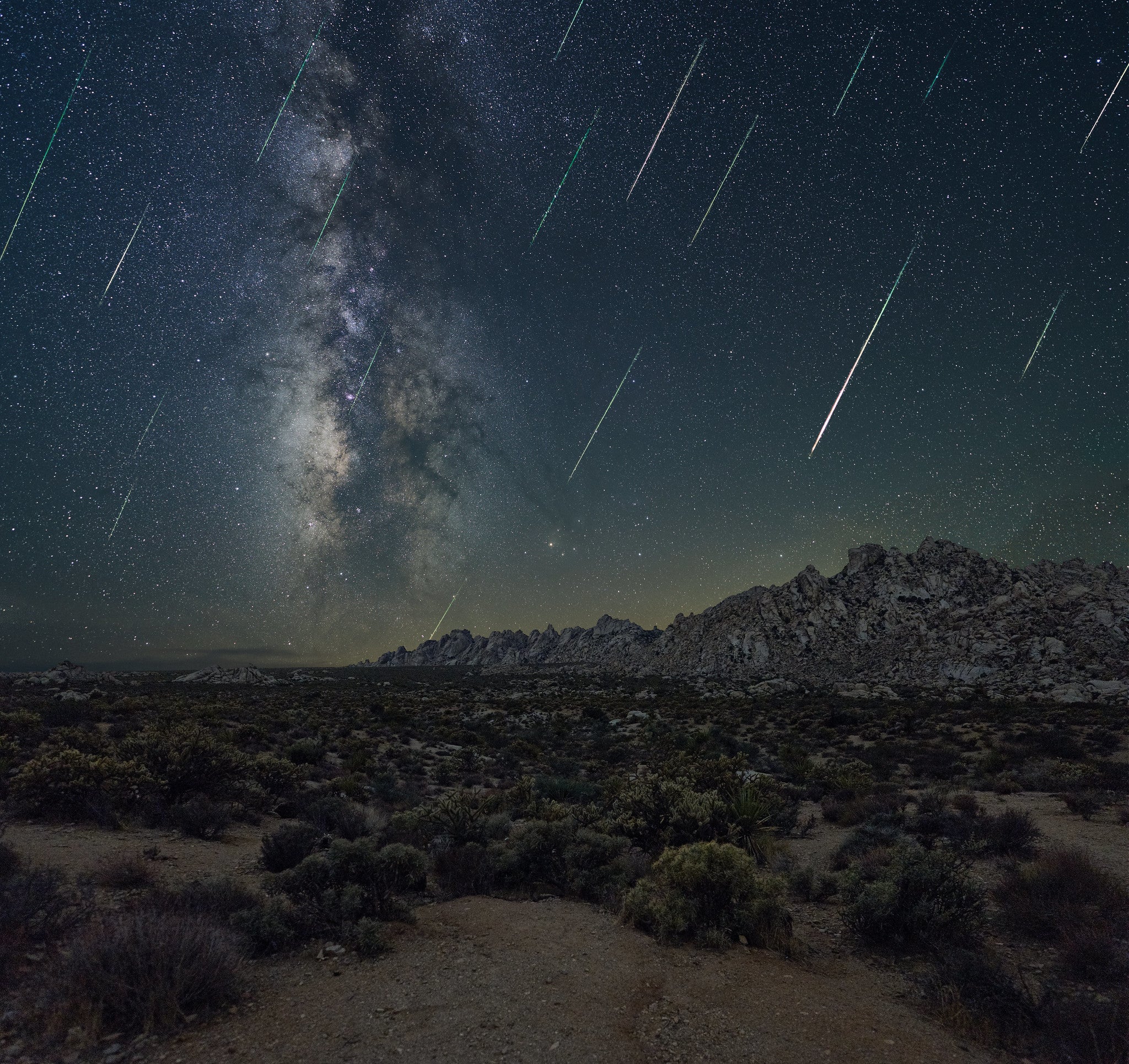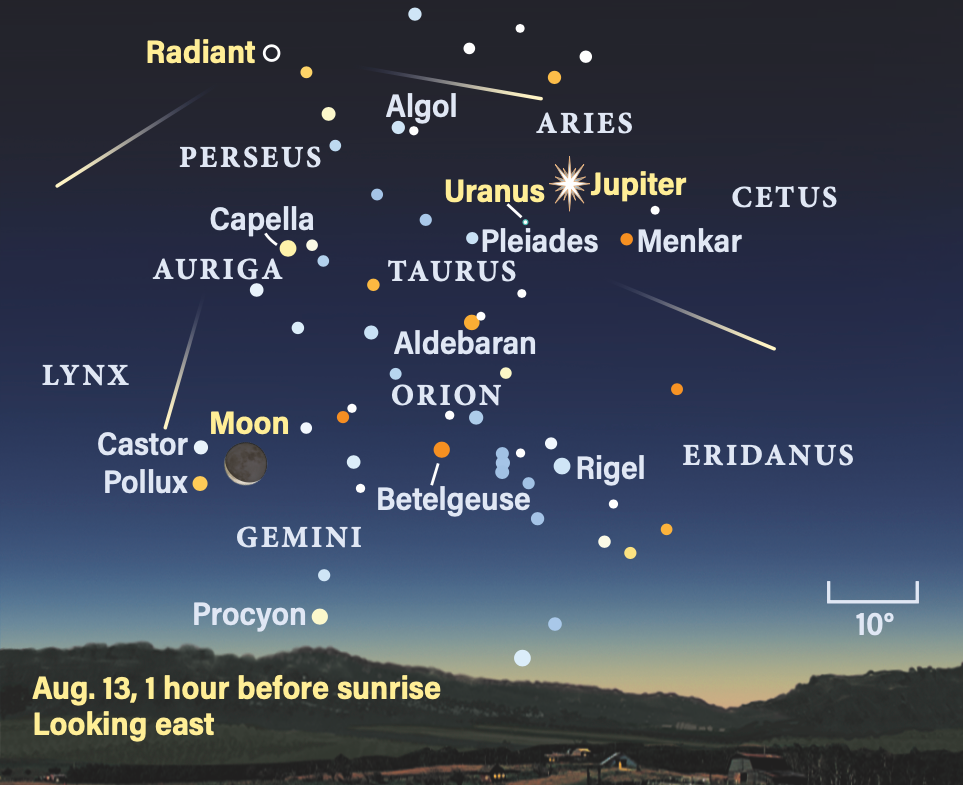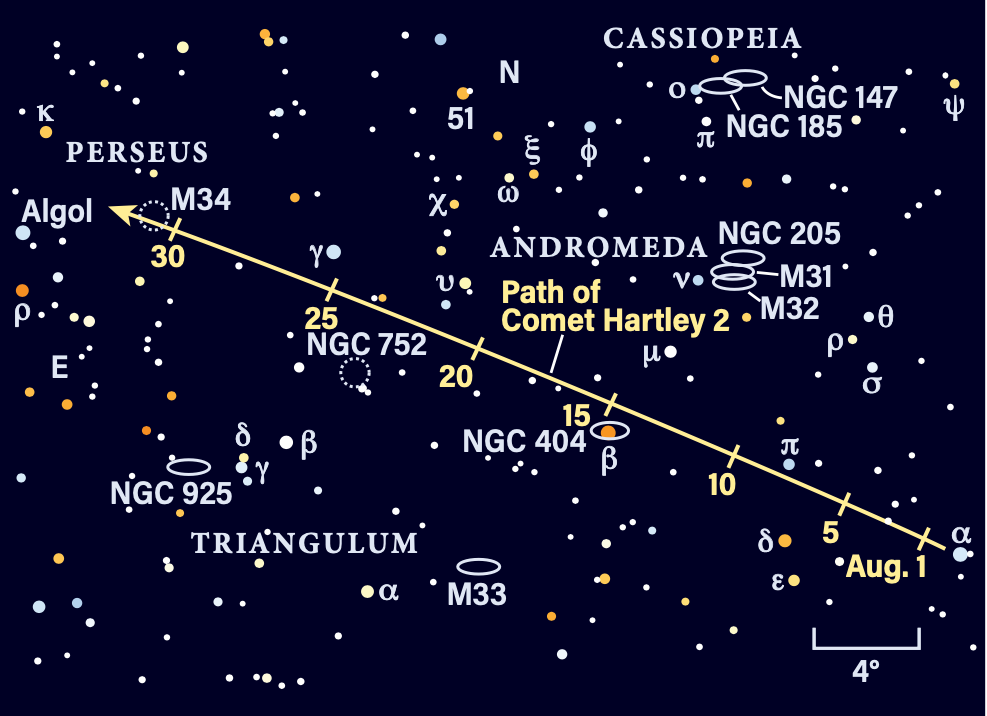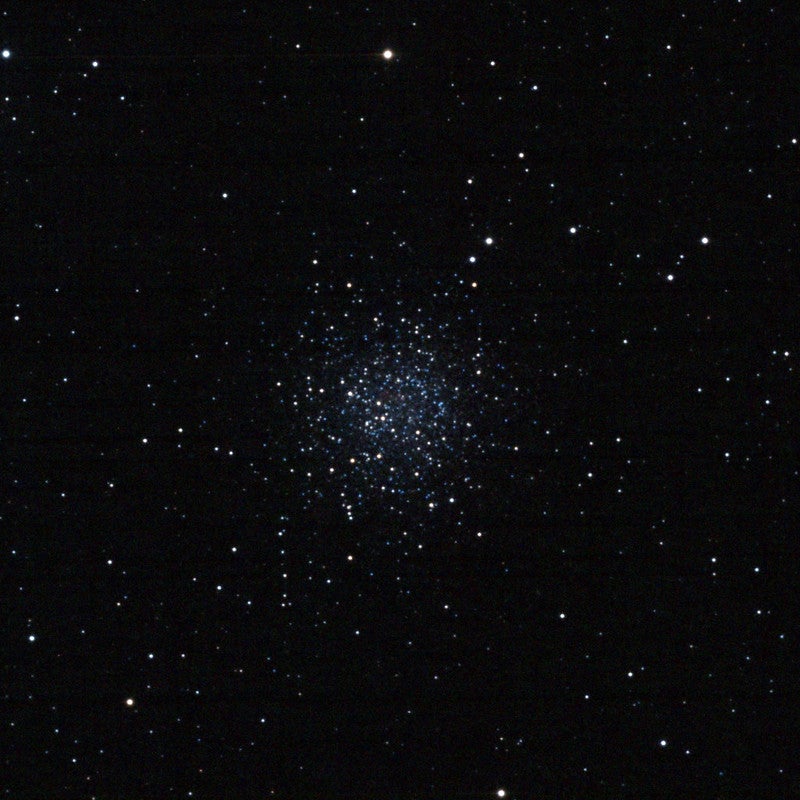
Friday, August 11
Asteroid 9 Eunomia is sliding through Sagittarius, tonight appearing to form the apex of a triangle whose base is marked by the globular clusters M22 and NGC 6642.
You’ll find Sagittarius in the south after sunset — see if you can locate the famous Teapot asterism, its spout tilted slightly toward the horizon. Eunomia is located just off the tip of the Teapot’s lid, marked by 3rd-magnitude Kaus Borealis (Lambda [λ] Sagittarii). From this star, slide about 3° northeast to land on magnitude 9.5 Eunomia, visible with binoculars or a small telescope.
About 40′ to Eunomia’s southeast is 5th-magnitude M22, a bright, dense cluster of stars. At about 10,000 light-years away, M22 is quite close and covers a large area of sky: about half a degree. Because it’s so bright and big, it’s easy to find and an excellent object to enjoy under magnification.
Next, roughly 1° to Eunomia’s southwest is NGC 6642, a much fainter 9th-magnitude globular that lies more than twice as far as M22. As a result, this cluster only spans about 1/3 of M22’s apparent width. It will thus appear much smaller and its stars are harder to resolve; it may look more like a condensed ball of fuzz with a slightly brighter center.
Sunrise: 6:08 A.M.
Sunset: 8:02 P.M.
Moonrise: 1:23AM
Moonset: 5:23 P.M.
Moon Phase: Waning crescent (19%)
*Times for sunrise, sunset, moonrise, and moonset are given in local time from 40° N 90° W. The Moon’s illumination is given at 12 P.M. local time from the same location.
Saturday, August 12
The Square of Pegasus is a famous asterism (an unofficial pattern of stars not considered one of the official 88 constellations) visible in the evening sky tonight. Look east after dark for a square-shaped pattern of four bright stars slowly rising over time. These are magnitude 2.4 Scheat (which appears highest in the sky), magnitude 2.5 Markab (to Scheat’s lower right), magnitude 2.8 Algenib (directly below Scheat as Pegasus rises), and magnitude 2.1 Alpheratz (to Scheat’s lower left).
That brightest star in the Square, Alpheratz, actually belongs to Andromeda, the constellation immediately north and east of Pegasus. The other stars, however, do belong to the Winged Horse, whose neck and head appear southwest of the square, emanating from Markab. Picture Pegasus as the front half of a horse flying upward from the horizon with his neck outstretched; the 2nd-magnitude star Enif marks his nose. As the night progresses, Pegasus rises up and then makes a turn toward the north, appearing to arc over the North Celestial Pole and the North Star, Polaris, in the early hours of the 13th, after midnight.
If you’re outside stargazing this evening and particularly if you’re up late, make sure to keep an eye out for Perseid meteors, which should be plentiful as the highly active shower peaks early on Sunday morning. Check out the next entry for more details.
Sunrise: 6:08 A.M.
Sunset: 8:01 P.M.
Moonrise: 2:12 A.M.
Moonset: 6:14 P.M.
Moon Phase: Waning crescent (12%)

Sunday, August 13
The Perseid meteor shower peaks this morning, with the highest rates of meteors occurring in the few hours leading up to local dawn. The shower’s radiant in Perseus is highest at that time, some 60° high in the east and just 2.5° northeast of the 4th-magnitude star Miram (Eta [η] Persei). Once you’ve found the radiant’s location, however, look away from it by at least 40° on either side — this is where the meteors with the longest trains will appear, streaking across the background sky.
Observers can expect rates of about one meteor per minute — though this is an average, so sometimes you’ll see a lot of meteors in a row and sometimes you may go several minutes without seeing any. Although the peak occurs this morning, you can also step outside again tonight after dark to catch plenty of shooting stars as the rate tapers off over the few days after the peak.
With no evening moonlight and only a thin crescent Moon early in the morning, this shower is set up to be spectacular. No equipment is required, and the pleasant weather means you can spend lots of time outside enjoying the show. Find more details for viewing or photographing the Perseids here.
Sunrise: 6:09 A.M.
Sunset: 8:00 P.M.
Moonrise: 3:08 A.M.
Moonset: 6:58 P.M.
Moon Phase: Waning crescent (7%)
Monday, August 14
The solar system’s standout gas giant, Jupiter, dominates the early-morning skies from its perch in Aries, just above the head of Cetus the Whale. Zoom in on the magnitude –2.5 planet with a telescope this morning to catch a small, dark blot of shadow slip onto the disk from the east and begin traveling west, starting around 3:20 A.M. EDT.
That shadow belongs to Europa, which sits east of the planet’s disk. Keep watching and you’ll see the moon close in on the limb, led by its shadow, though the two never cross the cloud tops at the same time. Europa’s shadow slips off the western edge of the visible disk just before 5:40 A.M. EDT, but the moon has not yet reached the eastern side of the planet. Europa finally begins its own transit just after 5:10 A.M. CDT (note that this is essentially sunrise for much of the East Coast, so observers there won’t be able to watch this occur).
If you happened to catch the similar transit of Io earlier this month, you may notice there is a longer gap this morning between the appearance of Europa’s shadow on the cloud tops and the beginning of the moon’s transit. That’s because Io’s orbit is smaller compared to Europa’s and the former sits closer to Jupiter, and so the time between shadow and moon transits is less.
Sunrise: 6:10 A.M.
Sunset: 7:58 P.M.
Moonrise: 4:08 A.M.
Moonset: 7:34 P.M.
Moon Phase: Waning crescent (3%)

Tuesday, August 15
Rising in the east as the night progresses is Andromeda the Princess. Tonight, we’re homing in on her beta star, magnitude 2.1 Mirach. Turn a telescope on this sun and you’ll see a faint, fuzzy “ghost image” of the star just 7′ to its northwest. Is this a reflection in your optics? No! It’s the galaxy NGC 404, also called the Ghost of Mirach because of its proximity to the bright star.
Of course, the two are not close in space — the galaxy lies 10 million light-years beyond our own, while Mirach sits squarely in the Milky Way, just 200 light-years from Earth. But the resemblance is uncanny, particularly in photographs, as the galaxy’s aging stellar population gives its light an amber-red glow similar to the color of Mirach. It’s a fascinating pair, but tonight, there’s something unique going on.
A second “ghost” has joined the party, about 1° north. This is Comet 103P/Hartley 2, magnitude 13 (or thereabouts) and brightening on its way toward the inner solar system. With careful observation or through photographs, you may notice that this particular ghost is greenish, thanks to the diatomic carbon that makes up the comet’s coma.
Sunrise: 6:11 A.M.
Sunset: 7:57 P.M.
Moonrise: 5:10 A.M.
Moonset: 8:04 P.M.
Moon Phase: Waning crescent (1%)
Wednesday, August 16
New Moon occurs at 5:38 A.M. EDT this morning. Just over two hours later the Moon reaches apogee, the farthest point from Earth in its orbit, at 7:54 A.M. EDT. At that time, our satellite will sit 252,671 miles (406,635 kilometers) away.
This timing is important. You may remember that the Moon reached perigee, the closest point to Earth in its orbit, right around the time of the last Full Moon on the 1st. This coincidence rendered that Full Moon a Super Moon. Now, at New Moon, our satellite is at its farthest. These cycles will still be lined up enough that the next two Full Moons will also be Super Moons: on August 30 (also a Blue Moon, as it’s the second Full Moon in a single calendar Month) and September 29.
Right now, though, New Moon is the perfect time to catch another comet. Comet C/2023 E1 (ATLAS) is slightly brighter than yesterday’s cometary target. Recently past perihelion, when it came closest to the Sun, ATLAS is starting to fade as it makes its way back toward the outer solar system on its 85-year orbit. ATLAS is now around magnitude 10 and located in southeastern Cygnus, passing just ¼° northwest of magnitude 5.7 79 Cygni tonight. It lies about two-thirds of the way on a line drawn from Deneb to 4th-magnitude Pi (π) Pegasi.
Southeastern Cygnus also contains two popular observing targets. NGC 7000, also known as the North America Nebula, lies just southeast of Deneb. And the Veil Nebula Complex, a huge supernova remnant containing NGC 6960, NGC 6992, and NGC 6974, sits near the border of Cygnus and Vulpecula, about halfway between Zeta (ζ) and Epsilon (ϵ) Cygni. While the sky is dark and moonless, it’s a great time to enjoy these favorites as well.
Sunrise: 6:12 A.M.
Sunset: 7:56 P.M.
Moonrise: 6:12 A.M.
Moonset: 8:29 P.M.
Moon Phase: New

Thursday, August 17
The constellation Libra is slowly setting in the west as darkness falls at this time of year. The Balance hosts no Messier objects but contains a wealth of other deep-sky targets, including NGC 5897, sometimes referred to as the Ghost Globular.
This ancient cluster of stars shines at magnitude 8.4, making it an easy catch for binoculars or any small scope for a few hours after sunset. It’s located in the middle of the constellation, about 11.5° due south of Zubenesch, Libra’s magnitude 2.6 beta star. Iota (ι) Librae, a magnitude 4.5 star, can serve as a closer jumping-off point: NGC 5897 is just over 1.5° southeast of this star.
The Ghost Globular spans about 12.6′ on the sky. You may notice that its center is fairly sparse, a departure from the “usual” look of globular clusters, which tend to be very dense and concentrated in the middle. You may also notice the colors of some of its brightest stars — particularly in photos, the contrast between the cluster’s cooler orange stars and hotter blue stars is readily visible.
Sunrise: 6:13 A.M.
Sunset: 7:54 P.M.
Moonrise: 7:13 A.M.
Moonset: 8:51 P.M.
Moon Phase: Waxing crescent (2%)
Friday, August 18
The Moon passes 1.1° north of asteroid 2 Pallas at 7 A.M. EDT. At the same time, our satellite passes 7° north of the planet Mercury. Twelve hours later, the Moon passes 2° north of Mars at 7 P.M. EDT, shortly before you can catch the planetary party in the evening sky.
Look west about 30 minutes after sunset to try to catch magnitude 0.7 Mercury first. It’s the lowest of the bunch, just 2° high at that time. Unless you have a very clear horizon free of trees and buildings (and any clouds), you may not see it. Scanning the horizon slowly with binoculars after the Sun sets may help, but take care not to use any optics until the Sun is completely below the horizon from your location.
Pallas is a little higher than Mercury, but much more challenging because of its magnitude of 9.1. Wait until at least 45 minutes after sunset, then see if you can spot magnitude 2.1 Denebola, the tip of Leo’s tail. From there, drop straight down toward the horizon to find 4th-mangitude Iota Leonis. 4.5° south of this star is 4th-magnitude Sigma (σ) Leonis, which sits just 1° southeast of Pallas. If you can center Sigma in your field of view, Pallas should also be visible. Again, though, the scene is sinking fast and you may lose it before the background grows dark enough for your optics to show the asteroid.
Never fear, though — we’ve saved the best for last. Magnitude 1.8 Mars sits in far western Virgo, still south (to the lower left) of the less-than-three-day-old Moon. Binoculars or a telescope should reveal the tiniest sliver of the Moon’s sunlit crescent in the lunar east. The dark, nearly circular splotch of Mare Crisium may even be visible in the northeast. Take your time examining the terrain here — with such a small portion of the disk illuminated, features along the limb should stand out in stark contrast, offering a unique view.
Under magnification, Mars will show off a tiny 4″-wide disk. The Red Planet now lies nearly 228 million miles (366.5 million km) from Earth.
Sunrise: 6:14 A.M.
Sunset: 7:53 P.M.
Moonrise: 8:13 A.M.
Moonset: 9:12 P.M.
Moon Phase: Waxing crescent (5%)

Sky This Week is brought to you in part by Celestron.









